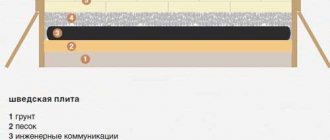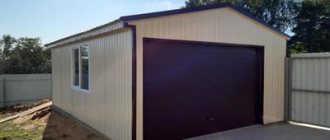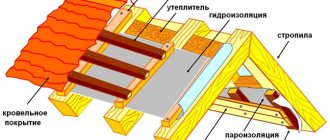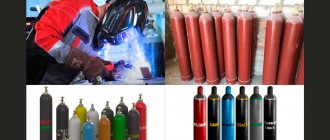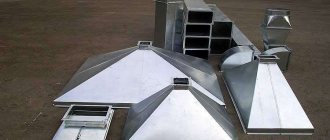An alternative to metal products for preparing barbecue is a brick grill. It can be used as a separate device or with additional functions of a stove, smokehouse, or barbecue grill.
Masonry of massive structures is labor-intensive and requires knowledge and experience. If the owners want to manually master the principles of brick laying, then it is better to do this under the guidance of a master, following his instructions.
A brick barbecue will be a beautiful and practical addition to a summer cottage or estate in the private sector.
We recommend reading:
- How to make a tandoor at the dacha with your own hands
- How to build a tandoor from brick
Varieties by location
Installation is permissible both indoors and outdoors. Taking this factor into account, barbecues come in two types.
Street (garden)
It is mounted under a small canopy so that precipitation and moisture do not get inside the chimney, and you can cook in any weather.
Another option is to do it outdoors, in the garden, near a gazebo, near the house. In any case, a reliable foundation is poured under the structure. A monolithic slab is considered optimal.
The masonry of the barbecue is made of fire-resistant bricks, the cladding is made of moisture-resistant materials.
It is important to choose the right location for the garden structure, taking into account the direction of the wind, so that there are no dry trees or wooden buildings nearby. To avoid conflicts with neighbors, it is better to first familiarize yourself with the SNiP standards.
To the gazebo (veranda or terrace)
Installed in open and closed buildings. At the project development stage, fire safety requirements are taken into account, and the location for the chimney outlet is carefully considered. Requires pouring a separate foundation.
It is recommended to lay out the floor covering near the stove from non-flammable materials:
- paving, ceramic tiles;
- clinker bricks;
- artificial, natural stone.
An alternative is to place a sheet of iron or steel on the floor at a distance of 1.5 m from the stove.
Visually, the room is divided into zones: kitchen and dining.
Preparation for construction
The first important step in arranging a barbecue will be choosing the place where the stove will be installed. When choosing a site for its placement, you must be guided by the following recommendations:
- The distance from the structure to the house should not be too large, since preparing a dish will require repeated trips to the main kitchen for utensils, food, spices, etc.
- Trees and shrubs should not grow near the fireplace.
- Take into account the prevailing wind direction in the area; smoke from the stove should not go towards residential premises.
Next, you need to decide what the future structure will look like, draw or select an approximate drawing of a barbecue on construction sites or in special magazines, and decide on its dimensions.
When creating a design diagram, be sure to take into account the individual features of the landscape on the site, plan so that the grate or any other main barbecue cooking surface is at a safe and comfortable height for the person cooking.
Before starting the stove manufacturing process, be sure to decide on the design of the future structure; it is best that it is made in the same style as the country house and favorably complements the overall design of the land plot.
In a large free space, you can place a large barbecue that combines various work areas; in a small area, a compact oven with an optimal set of functions will look great.
Furnace configuration
In any type of stationary furnace, it is necessary to have a reliable foundation, which will ensure long service life.
You should also be responsible when choosing fuel. It is unacceptable to use firewood from coniferous trees, resinous fruit trees (plums, cherries), lumber impregnated with resin.
To ignite, take matches and a special liquid. It is prohibited to use gasoline or kerosene to create a flame. There will definitely be no benefit from adding such components to food. But it can cause harm to health after consumption.
Simple design
Such buildings are often used in summer cottages. This is the most popular option for homemade structures, as they do not require in-depth knowledge of masonry techniques.
To protect against rain, it is recommended to supplement them with a dome-shaped smoke collector. For ease of use, a medium-sized tabletop is built in. The optimal building material is fireclay brick. Fuel – charcoal, firewood.
Photo: small barbecue with a rain cover
If you follow the step-by-step masonry technique, the fire will not come into contact with metal elements, which means that the walls and bottom will not burn out and the grill will last many times longer.
Such designs do not have holes for air access, which significantly saves firewood. They do not burn out quickly, but smolder.
The finished grill will not take up much space on the estate. This is a budget stove for seasonal use.
With smokehouse
Standard factory kits of fire-resistant brick barbecue stoves do not include a smokehouse. It can be purchased additionally if the product model includes a built-in wood-burning stove.
The smokehouse is made of stainless steel sheets with a thickness of 2 mm. Inside there are 2 levels of grates on which products for smoking are placed. Equipped with a groove for a water seal. If water gets in, the tightness of the shutter prevents smoke from escaping.
Layout diagram of a compact barbecue
The smokehouse is attached to the place where there should be a stove or cauldron on top of the stove. To start the device, the VFS (built-in wood stove) is ignited. Wood shavings smolder inside the smokehouse and hot smoke begins to form.
With cauldron, stove
A cauldron with a stove can be equipped independently with a built-in wood-burning stove or be part of a barbecue complex, complemented by a countertop and sink.
A red brick grill is laid out. The side, rear and front brick walls form the oven chamber. From the outside of the structure, only the firebox door and the ash pan handle are visible. At the top of the stove there is a round hole for a cauldron or stove, at the bottom there is a grate, an ash pan that extends.
Built-in wood stove - source of heating for the cauldron and stove. For the firebox, it is better to take firewood and chipboard briquettes.
The complexes are equipped with an 8-liter cauldron, but it is possible to install containers with large dimensions up to 12 liters.
The chimney is made from a double-circuit sandwich pipe of rectangular cross-section. The upper part of the pipe is discharged into the smoke collector.
With grill, barbecue
The usual grill shape is a deep, round frying pan with a barrel-shaped lid. If the lid is closed, the food is cooked evenly on the sides, bottom, and top.
Barbecue differs from grilling in that the product is fried only from below, and not from all sides. This is due to the lack of a lid.
The inside of the device is very similar. The main detail is the gratings. Fish and meat are laid out on the top grate, fuel is placed on the bottom grate. For comfortable cooking, the upper grill can be adjusted to 3 positions.
Unlike a barbecue, the grill has openings with dampers so that air access can be regulated.
There is a retractable ash pan where ash and ash accumulate. Many factory models are equipped with a spit and folding table. There are grills with double clamping grates.
Before the first use, the grill or barbecue is thoroughly lubricated with vegetable oil, pierced and allowed to cool.
With canopy (roof)
Photo: garden grill with a canopy made of metal and polycarbonate
A covered canopy is an excellent protection from precipitation, especially in winter, when the water begins to freeze and melt. It is recommended to assemble the canopy from fireproof materials - metal racks and corrugated sheets, metal tiles.
If it is not possible to build a shed, then it is necessary, at least temporarily, during the period of precipitation, to cover the grill with thick plastic film.
Precipitation falling on the structure at an angle will not cause harm.
Angular
This barbecue design is becoming increasingly popular. Placing the device along the walls, adjacent to the corner, allows you to significantly save space. This is especially true for small summer cottages and gazebos.
The requirements for materials are unchanged - moisture resistance, fire safety.
Corner placement is an excellent option for barbecue complexes, where it is convenient to place a tabletop, sink, niches for firewood and utensils on the sides.
However, such a structure cannot be built by beginners. It requires competent calculations and knowledge of masonry techniques, so it is better to invite a specialist.
Fireplace-barbecue
Interesting type of combination. The fireplace is:
- built-in;
- free-standing.
The built-in fireplace is an element of the barbecue complex. The fireplace module is installed instead of a barbecue or vice versa.
When using a fireplace insert, a large load of firewood is allowed at one time. It is carried out into the firebox. When installed indoors, the fireplace barbecue will become a source of heating in cold weather.
With countertop, sink
The working surface of the tabletop is built-in or can be placed separately. Collapsible models are available.
Installation is carried out on the left or right side (at the discretion of the owners).
It is necessary to determine the location at the stage of developing sketches, so that the factory can make a high-quality product that will be closely adjacent to the structure.
By adjusting the length of the tabletop, the complex can be adjusted to specific room sizes.
Equipping the complex with a sink simplifies and makes food preparation comfortable. For installation, attention is paid to the correct water supply and sewerage.
Barbecue complex
Multifunctional design. Difficult to build on your own.
It has several departments:
- built-in wood stove;
- plate;
- oven;
- barbecue;
- B-B-Q;
- smokehouse;
- cauldron;
- spit;
- tabletop.
The set of elements differs depending on the model.
It can be installed both for outdoor use and in closed buildings such as a summer kitchen or gazebo. With the right choice of material for cladding, it looks very beautiful.
Users often search for:
- How to make a patio
- Vertical barbecue grill
Benefits of barbecue
The main advantage of this outdoor stove is its versatility; it will allow you to cook in the fresh air not only the usual barbecue, but also juicy steaks, steaks, bake any fish, various vegetables, dry mushrooms, berries, herbs, fruits, cook pilaf, soup, etc. . Installing a barbecue with a smokehouse in your dacha will allow you to enjoy smoked meat, seafood or fish.
The barbecue design is an ideal combination of the main advantages of a barbecue, a grill grate and a smokehouse, which makes this oven as efficient and effective as possible:
- it is equipped with a rear wall, this allows hot air to be evenly distributed throughout the entire internal volume, ensuring that the optimum temperature is maintained inside;
- the provided chimney does an excellent job of removing unnecessary smoke from the cooking area;
- The combustion process is carried out in a specially equipped firebox. This advantage makes using the stove safer, more secure and durable;
- it uses the created heat more efficiently; even after the cooking process is completed, the structure will be warm.
If you plan to install a barbecue in semi-enclosed gazebos or terraces, an additional advantage may be that the stove will heat the room, which will allow you to relax comfortably in nature even in the cold season.
Choosing a suitable location on the site to install the stove
To determine the installation location, it is recommended to consider the following points:
- The structure should be located near the recreation area (gazebo, veranda, summer kitchen).
- The terrain should be smooth, without sudden changes.
- Convenient approach to the grill. If possible, one or more paths are developed.
- Communications supply. If, according to the plan, the product will be equipped with a sink, then the proximity of water pipes and sewerage will be taken into account. In winter, the access to water in garden barbecues is blocked so that the pipes crack in the cold.
- Direction of the wind. Smoke should not be directed towards the recreation area. You need to build it so that the smoke goes to another part of the yard.
- Presence of a canopy. Let’s assume the option of combining outdoor stoves with a table and chairs standing next to them.
Compliance with fire safety requirements requires that the device be located at a sufficient distance from green spaces, dry trees, and flammable outbuildings.
Modeling a barbecue
The modeling process allows you to visually design the future product, depict the design in detail, and figure out how the elements will be connected.
With a correctly assembled layout, you get a mini-version of the barbecue. It can be conveniently made from polystyrene foam and other lightweight materials.
Depending on the model, the standard design can be supplemented (optional):
- fireplace cassette;
- countertop with sink;
- built-in wood stove;
- oven (Russian oven);
- a work surface that can be raised (folding table);
- tandoor;
- cauldron, stove.
Order of the furnace complex
Each of the listed modules is built-in or, at the customer’s request, installed separately.
Features of metal structures
Metal barbecues can be either stationary for a summer residence, or mobile or folding. The first option is easier to assemble, as it only requires attaching legs concreted (or simply dug) into the ground. In this case, 2 supports submerged to a depth of 50-70 cm are sufficient.
Mobile structures are installed on more stable supports in the form of a sled or 4 legs. The wheels are attached to the bottom of the supports. Sometimes they install all 4, less often - 2 wheels so that the grill does not move when any pressure is applied to the side.
A folding metal barbecue is a box for coals, the legs of which are either completely detachable or mounted on fixed supports. This design option is convenient for those who like to go out into nature, have picnics, and hikes.
Brick selection
Expensive, but the most suitable for masonry is clinker, another name is refractory brick. The main raw material is special clay, which is fired at high temperature.
Comes in different colors:
- red;
- sandy;
- dark brown;
- red with tan marks.
Clinker bricks differ from inexpensive ceramic bricks in their high strength and long service life. It is resistant to moisture and frost.
The good thing about clinker is that the finished structure turns out beautiful and does not require additional cladding.
It is allowed to use cheaper ceramic, red fireclay bricks. Feature article: “Brick for masonry stoves.”
It is important to take into account that silicate (white) brick is not suitable for creating a barbecue at home, because it begins to quickly deteriorate under the influence of moisture, temperature changes, and cannot withstand high temperatures.
Brick cutting and chopping
A grinder with a stone cutting disc is perfect for cutting brick. During operation, a lot of dust is generated, so it is recommended to protect your eyes and respiratory organs with goggles and a mask.
The process takes place in the following sequence:
- Marking bricks with a pencil, ruler or tape measure.
- Cutting (splitting) elements to the required sizes.
- Teska (grinding) of the resulting blanks.
To speed up the marking process, experts recommend making templates. This is especially effective in cases where it is necessary to cut parts of the same size in large quantities.
Material for templates - pieces of roofing felt, parchment, thick cardboard.
To make templates of non-standard shapes, you need to use ingenuity. For example, to get a longitudinal half of a brick, it is enough to bend the template of an ordinary half lengthwise. This will reduce the number of templates and speed up the cutting process.
Parts for which templates cannot be made (bevels, oven appliances) are marked during preliminary dry laying.
When cutting, you need to work at high speeds, otherwise even a new disk will quickly wear out.
It is not necessary to make a full cut, just a cut is enough and then carefully split. But this applies to cases of obtaining parts of simple shapes. For complex elements, it is better to cut the workpiece to the end.
Experts recommend using a new disk to first cut off complex parts, then simple ones, since standard parts can be cut off even with a worn disk.
It is worth saying that cut parts have a smooth surface, chipped parts have a rough surface, sometimes even with defects. You can smooth out the roughness:
- processing with a grinding disc;
- grinding the chopped parts against each other;
- with a pick.
It is better to place bricks with chipped edges against a thick seam.
How to make a foundation?
First you need to dig a shallow (30-50 cm) U-shaped trench, pour and compact gravel, put a reinforcing mesh or lattice of rods on it and mount the formwork. Then fill everything with concrete mixture. In order for the base to dry well and acquire the necessary strength, it will take from several days to one week. Only then can you begin building the barbecue itself. In order for the solution to harden equally over the entire area of the base, concreting must be done at one time. The concrete mixture must be compacted to avoid the appearance of air bubbles.
Preparation of the solution
The main components of the masonry mixture are clay and sand. The recommended proportion is two parts sand to one part clay. The day before mixing the solution, the clay is soaked in water.
An important feature of clay is that the fatter it is, the greater the sand consumption.
If the consistency is correct, the solution will slide off the trowel, leaving a small mark on it. If it falls off without any traces, then a lot of sand has been added; on the contrary, it smears a lot - there is an excess of clay in the mixture.
For laying the main parts, cement is not added to the mixture due to low heat resistance. But it is permissible to cover the grill with facing material using cement mortar.
Variety of gazebos with photos
Below we have prepared a small selection of photographs that you can use as a guide for your future construction.
If you want to find even more examples, then go to the publication about gazebos with barbecue, barbecue and stove (). There you will find them in abundance.
If you still have any questions about this topic, then do not hesitate to ask them in the comments. We will try to answer you within 24 hours.
Required Tools
To work you will need:
- shovel;
- Master OK;
- a trough for mixing mortar or a concrete mixer;
- buckets;
- building level, tape measure, plumb line;
- Bulgarian;
- reinforcing mesh;
- cement, crushed stone, sand, clay;
- fireclay brick;
- boards, plywood (for formwork assembly);
- metal corners, doors, grates, grates;
- hammer;
- mallet;
- rope and pegs (for marking under the foundation).
In order to save money, it is allowed to purchase fireclay bricks only for laying the firebox. For other areas of the oven that will not be exposed to high temperatures, you can take regular brick (not necessarily new).
We will analyze step by step the process of independently erecting a small outdoor barbecue, and clarify the nuances of each action.
Schemes and drawings
The work process reflected in the drawings
Developed during the planning stage. The drawing is a visual representation on paper of the future structure, where the shape, dimensions, and cross-sectional view are clearly visible. Created on a scale with a reduction several times from the actual dimensions.
For example, when specifying a scale of 1:10, it means that the design drawing is reduced by 10 times. For every 1 mm of drawing there is 1 cm in reality.
Corner barbecue diagram
It is customary to use a thick solid line to show the outline of the product. Thinner lines indicate the sizes of the elements.
Block barbecue diagram
Conventional shading in the drawing indicates the raw materials used for construction. For example, under an ordinary red brick, hatching is drawn at an angle; fireclay (fireproof) is marked with a check.
The drawing description includes the following details:
- general view of the product;
- outside view - facade;
- structure in a vertical section, where the internal structure is visible;
- horizontal section showing the principle of masonry.
Recommended oven sizes
The width of the barbecue when folded should correspond to the width of the skewers - 47-62 cm. The height of the frying platform is made slightly higher than the waist, so it will be more convenient to cook. The length of the firebox should be such as to simultaneously accommodate from 8 to 10 skewers.
Preparatory work
They consist of clearing the construction site of debris, vegetation, and marking. For the last step, rope and wooden pegs are used.
Foundation installation
A brick barbecue is a heavy structure, so it is recommended to pour a monolithic concrete slab under it.
Briefly, the procedure for constructing the foundation looks like this:
- A hole is dug with a depth of 30 cm. The dimensions should be 20 cm larger on each side than the future product.
- The bottom is carefully compacted.
- A 15 cm thick cushion is poured from layers of sand and gravel. It's being compacted. Moisturized with water.
- The formwork is assembled from boards. The knocked down frame is placed around the perimeter of the dug hole.
- The bottom of the pit is reinforced with metal mesh.
- Cement mortar is being poured. The M500 brand is best suited for cooking.
- The poured mixture is pierced with a piece of reinforcement to remove air bubbles.
- The slab should extend above the ground level.
- Curing time is up to 4 weeks.
- In dry weather, to avoid cracks, the surface is moistened with water.
The frozen slab is covered with waterproofing (dense polyethylene, roofing felt) on top.
While the foundation hardens, you need to soak the clay for the solution. The finished solution should not crack when compressed.
You can get acquainted with other types of foundations for the furnace by clicking on the link.
It is important to think through the supply of communications even before the foundation is poured.
The day before laying, the brick should also be prepared. It is thoroughly watered so that it does not absorb moisture from the solution. The adhesion to the surface will be better.
Order of brickwork
The order should be carried out in the following sequence:
- It’s better to start by laying out the first row dry. This will allow you to adjust each brick to size if you need to trim it. The gap between the elements is 1 cm. The evenness of the diagonals is checked.
- Laying facing bricks can be done using a solution of cement and sand (in a ratio of 1:3). To improve the plasticity of the mixture, you can add a little lime. The recommended seam size is from 8 to 10 mm.
- In areas where bricks pass without dressing, it is necessary to carry out reinforcement with metal wire.
- Each subsequent row is shifted by half a brick. To adjust the elements to size, use a grinder.
- Every 3 rows, compliance with the masonry level is checked, and preferably more often.
- After 8 rows you need to create jumpers for the grill and countertop. To do this, take metal corners measuring 45*45 mm and set them up like an inverted letter T. Half of the shelf is sawed off. The metal should not come into close contact with the brickwork.
- Afterwards you can start laying the firebox. Fireclay bricks are connected to each other with clay-sand mortar. The thickness of the seams is no more than 4 mm.
- Metal corners are also used to form support for the bottom.
- The second row of bricks for the firebox completely covers the first. This way the seams will not burn through. Some craftsmen replace the first two rows of masonry with a concrete slab, but the creation will cost many times more, although it will be no less reliable.
- Parallel laying of the firebox and facing bricks is allowed. But between the lining and the firebox there is always a gap of 1 cm so that they do not touch.
To improve the decorative appearance, stove makers resort to constructing a combustion arch. To do this, a wooden blank is first made in the form of a semicircle and placed in the barbecue portal. Next is the masonry. Bricks are cut to the required sizes using a grinder.
The arch made of facing bricks must be covered from the inside with a fire-resistant lintel. Placed on a metal corner.
Masonry
The brick oven is laid using a standard set of masonry tools, which includes:
- level, plumb line, square;
- cords;
- templates for masonry joints of different thicknesses (for the firebox and chimney - 3 mm, for other parts of the stove body - 5-8 mm);
- trowels;
- mallet;
- pickaxe, grinder with a disk for adjusting the dimensions of bricks and steel angles;
- jointing
The first rows are laid out dry first. They check the proportionality of fireclay and ordinary bricks, determine the size of the trim where it is necessary.
Then the laying begins. An ordinary brick is moistened by dipping it in a bucket of water for a couple of minutes. Fireclay bricks are only rinsed. After adjustment, the fireclay brick must be laid so that the side pounded with a mallet or cut with a disk faces outward, and not into the firebox or chimney. The masonry process itself involves bandaging the seams, with periodic monitoring of the vertical walls and horizontal seams.
After finishing the masonry, the stove is dried under natural conditions for 5-7 days. And then they are heated for one to two weeks (depending on the size and weight of the structure).
Small brick barbecue project for beginners:
Chimney device
When the chimney continues to be laid out of brick, the order of work is as follows:
- The top of the combustion and facing parts are brought out to one level.
- To lay the smoke collector, a solid brick is taken. The solution is cement-sand. Cement grade – from M150.
- The first row is flush with the inside of the firebox. All subsequent ones are shifted by ⅓ of the brick.
There is no need to shift it over a greater distance, otherwise the bricks will simply fall inside the firebox over time.
- The laying is carried out until a small opening remains (30*30 cm, 25*25 cm).
- The finished brick chimney is covered with a protective cap on top to prevent moisture and precipitation from getting inside.
There is an option for mounting a chimney made of heat-resistant concrete or a double-circuit chimney made of sandwich pipes.
Read step-by-step instructions for installing a chimney made from sandwich pipes.

